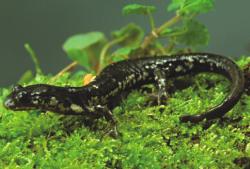- Wehrle's salamander
Taxobox | name = Wehrle's salamander

regnum =Animalia
phylum =Chordata
classis =Amphibia
ordo =Caudata
familia = Plethodontidae
genus = "Plethodon "
species = "P. wehrlei"
binomial = "Plethodon wehrlei"Wehrle's salamander ("Plethodon wehrlei") is a large
salamander with webbed hind feet. It is bluish-black with big, scattered white spots on its back. Its sides are covered with white to yellow spots and blotches. Its belly and the ventral surface of the tail are solid gray, and the throat and upper chest usually have white or yellowish blotches. The species grows to a length of 10-17 cm. Mating occurs from fall through spring. A large cluster of eggs is laid in early summer in damp logs, soils or moss, and in crevices in caves. Reproduction is biennial or irregular, with many mature females failing to breed each year. This species stays under cover during the day, and comes out to forage at night. This species is found on forested hillsides in theAppalachian Plateau , where it hides by day beneath stones or rocks. It is also found at the entrances of caves and deep rock crevices, as well as burrows under rocks and logs.Wehrle’s salamander has only been sighted in two locations: In Ohio along Sunfish Creek in Monroe County and along the
Little Muskingum River in Washington County.It is named in honor of
R. W. Wehrle . The species was the first described from one of his many collections.
Wikimedia Foundation. 2010.
